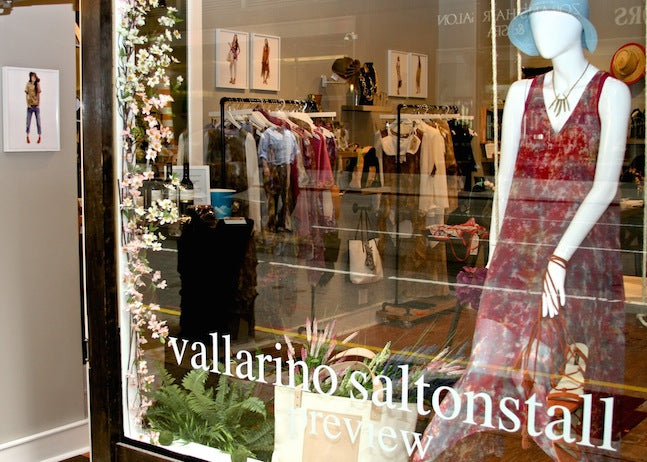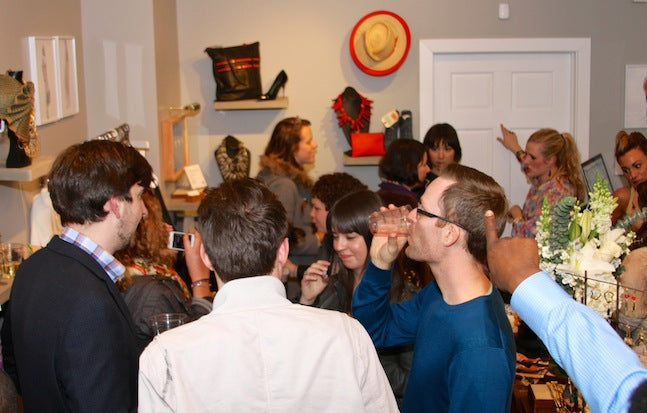This is a guest post from Melissa Gonzalez, Founder of the Lion'esque Group.
Last winter, the designers behind VallarinoSaltonstall contacted our offices inquiring about popping up for spring at RSPOP, one of our partner spaces at the Roger Smith hotel. This was their first experiment with brick-and-mortar retail and they wanted to “get it right”.
For the following three months, we worked closely with designers Hattie and Vanessa to conceptualize and plan for their first pop-up store.
The original plan was for a 1 month pop-up and after a successful opening they extended for two months. Wanting to profile their success as inspiration for other brands interested in doing a pop-up, I interviewed them for a case study around how they went from idea to executing their pop-up for two whole months.
From merchandising and marketing to how weather and store hours affected sales, here is what Hattie and Vanessa had to share about their experience.
1) What made you decide to do a pop-up? What were your goals?
We wanted to change our strategy up. We have only done wholesale throughout our years of business; attending all the regional tradeshows and working directly with buyers.
We had only seen one side of the business and wanted to experience working with the public and seeing how our collections would be perceived as.
Specifically, we wanted to know what styles would sell? Who our costumer is? What sizes sell more? What colors sell more?
Our goals while doing the pop up was to interact as much as we could with our costumer to have a better understanding of who we are dressing, while promoting our pop up and getting our brand out there as much as possible.
2) How did you go about budgeting for one?
Budgeting for the pop up was basically us doing as much as we could do ourselves while trying to keep costs at a minimum, especially as this was our first time.
Since our apparel is cut to order, we went through all of our styles to determine what we thought our best styles were. After that we budgeted what we thought we could make verses what we were willing to cut.
We also tried to find materials that we would use in the build out of the store that we could get multiple uses from.
3) What was the process like when first looking for a location?
The process wasn’t very difficult. It was more so rationalizing what months would be best to do the pop-up in. Searching for the best deal, location and months were our biggest worry.
We then worked with Melissa and the Lionesque Group on strategizing the best way to portray our brand using window displays and in-store merchandising.

5) What components did you DIY vs. outsource to professionals?
As we mentioned above, we really wanted to take a more DIY approach to keep our expenses low, so we ended up doing a lot ourselves, such as:
- Building our rack system/tables
- Designing the space / interior
- Social Media advertising
- Postcards, ads
- Making / Designing the clothes
- Photography
- Representing other designers for the store
- Designing the window display
The only thing we outsourced to professionals are manufacturing our clothes, in addition to hiring movers and having the interior walls painted.

6) How did you promote your pop-up shop?
The tactics we used to promote our pop-up shop included:
- Advertising on social media
- Having other designers spread the word
- Email Marketing via ConstantContact
- Promotional sales
- Weekly social events
- Postcard discount drop offs to local hotels
- Weekly sale discounts

7) How did you evaluate or measure your success? What trends did you learn about retail and about your customer?
Considering this was our first time ever offering our brand to the public and doing a pop-up retail store, at the end of it we felt as though we were very successful.
We definitely had our slow days, but overall it had been a very successful two months we did it for. This experience has helped us in so many ways as designers.
Thanks to the experience, we now have a very clear understanding of who our customer is, what sells more, what sizes sell more, what styles don’t work, and what fit is appropriate for our clientele.
This experience has opened our eyes in so many ways, where we are now finding ourselves wanting to open up our own boutique retail store.
8) Do you sell online as well?
We do sell online, we have our own website and we also sell on other ecommerce sites as well.
Our promotion strategy has always involved social media channels to advertise and promote as well as email marketing, not to mention doing things like handing out our business cards to people we personally meet.
What we have found is that considering we are a new brand that consumers aren't necessarily familiar with, it has been difficult to sell online when you're not such a well-known brand. This reason was a huge driver behind us wanting to do a pop-up in the first place.

9) What tips would you give small online retailers interested in doing a pop-up?
The biggest thing would be to "expect the unexpected," but some very practical things to consider before going through with your pop-up shop is to:
- Have enough inventory depending on what you are selling (size, quantity, variety)
- Have a range of price points
- Your marketing/advertising/sales strategy
- Creating a customer demographic profile or personas
- Researching pop-up locations and considering foot traffic first and foremost
- Understand who you will be attracting. Is it going to be locals, tourist, or business district?
- Keep the pop-up shop current, which includes rotating merchandise, and changing window displays and themes
10) What were some things that you spent time/effort on that ultimately didn’t work out?
The duration of our popup has been successful in many ways, and has allowed us to experience both the pros and cons of retail.
The biggest struggle we have encountered going into this venture as a (newbe) is knowing what will sell and what price points are appropriate. Also, collaborating with other brands has been time consuming, as well as a gamble.
Lastly, understanding the customer’s needs and wants are easier said than done when mixing in other designer products with your own, so having a clear product mix strategy from the onset is very important.
Despite minor challenges, we'd highly recommend pop-ups to not just learn more about retail but more importantly about who your customer is and what they want, because ultimately that's what will keep you in business.
P.S. If you liked this post, you'll love 8 Ways Pop-up Stores Can Boost Revenue and Build Buzz for Your Brand and A Fool-Proof Guide to Creating Window Displays that Turn Heads and Drive Foot Traffic

About The Author
Melissa Gonzalez specializes in brand activation and Pop-Up retail experiences. She is the founder of The Lionesque Group, a company that has produced over 65 pop-up retail experiences in New York, Los Angeles, and the Hamptons. Connect with her on Twitter.
